Recipes & Ramblings from Chef School
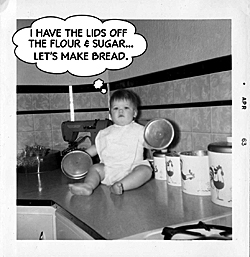 Bread was one of the first things my mother taught me to bake. The fragrance of freshly baked bread was as familiar as a Saturday night bath on a frigid evening in Iowa. I could often be found covered head to toe in flour, my hands gooey with bread dough, and a satisfied grin on my face.
Bread was one of the first things my mother taught me to bake. The fragrance of freshly baked bread was as familiar as a Saturday night bath on a frigid evening in Iowa. I could often be found covered head to toe in flour, my hands gooey with bread dough, and a satisfied grin on my face.
Today, the aroma of baked bread still evokes fond childhood memories, as did this week’s cooking class where we baked five different yeast breads and a pizza.
Basic bread contains very few ingredients – flour, water, yeast, and salt. Other additions can be oil, butter, eggs, sugar, milk, grains, and nuts. Today my goal is to cover the basic ingredients of a good bread.
Yeast
Yeast gives bread both flavor and an airy lightness.
Yeast is a single-cell organism. When activated, it digests sugar and flour. This process creates carbon dioxide bubbles that become trapped in the dough, causing the bread to rise. It also produces alcohol which burns off when baked. Remember yeast is alive and will grow when treated properly, kept it warm and well nourished. Sounds like something all of us need.
Because yeast is living, growth occurs as it is nourished with warmth, food (sugars), and time. Sounds like what we all need.
Yeast is also used for other purposes outside of baking such as brewing beer, fermenting wine, and as a nutritional supplement (Brewers Yeast).
There are three main types of yeast available to the home cook: fresh, active dry, and instant.
- Fresh/Wild Yeast
Fresh yeast is composed of live cells mixed with carbohydrates (commonly corn starch) that have been compressed into small square cakes, wrapped, and refrigerated to prevent spoilage. - Active Dry Yeast
Active dry yeast is dehydrated, dormant yeast cells clumped into grains that await reactivation. To revive the yeast, dissolve in warm water (about 110°F ) prior to mixing with the dough. - Instant Yeast
Instant yeast isn’t really instant, it’s about 50% faster in terms of rise time. Common names in the store are “Rapid-Rise” or “Quick-Rise”. It can be added directly to flour, which is great for bread machines.
Flour
Bread’s structure comes from two different types of protein in flour.
- Glutenin – which creates elasticity and then chewiness.
- Gliaden – which creates extensibility, the protein’s ability to stretch to achieve a higher rise.
These proteins need water in order to form gluten, the supporting structure of bread.
Different types of wheat flour contain different levels of protein.
- Unbleached all-purpose flour has the lowest amount of protein, usually around 10.5%. Works great for soft varieties such as white sandwich bread.
- Bread flour contains about 12%. Good for butter and egg-rich breads such as brioche.
- High-gluten and whole-wheat flours have about 14% protein. This is ideal for chewy breads like bagels.
TIP: Don’t use cake flour because there isn’t enough protein in it, and will cause your bread to fall.
Water
Water is needed to activate your yeast. If your tap water has an unpleasant taste, it is better to use bottled mineral water.
Salt
Salt flavors and strengthens your gluten. It helps control yeast development, and prevents the bread from over rising.
The Need to Knead
Kneading dough can be a rewarding experience. (My mother calls this process therapy, she says it’s a great way to work out frustrations and strengthen your upper body.)
Kneading also helps distribute the yeast cells uniformly throughout the dough, so it rises evenly and helps create a fluffy texture.
To knead dough by hand watch this video.
In Class Assignment
Alexis, my cooking partner for the evening and I were assigned to make pizza dough and sauce.
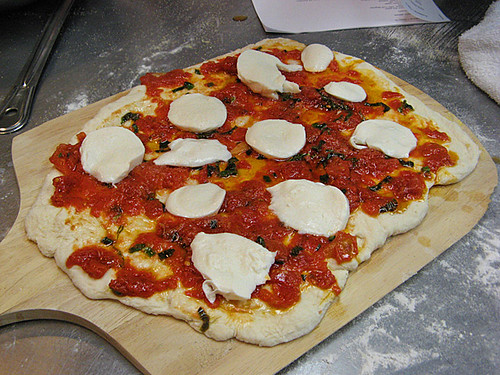
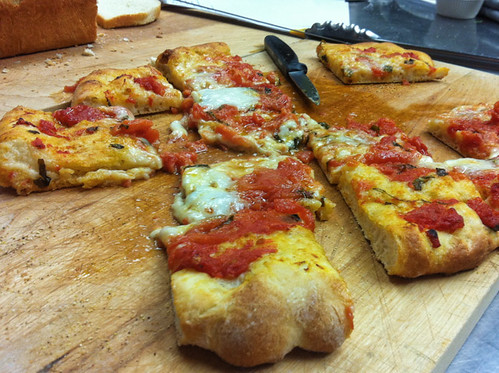
It has been years since I made pizza dough and it was Alexis’ first time. I think it is a good introduction to working with yeast dough, as it only has to rise once.
We were both impressed how easy it was and how good it turned out.
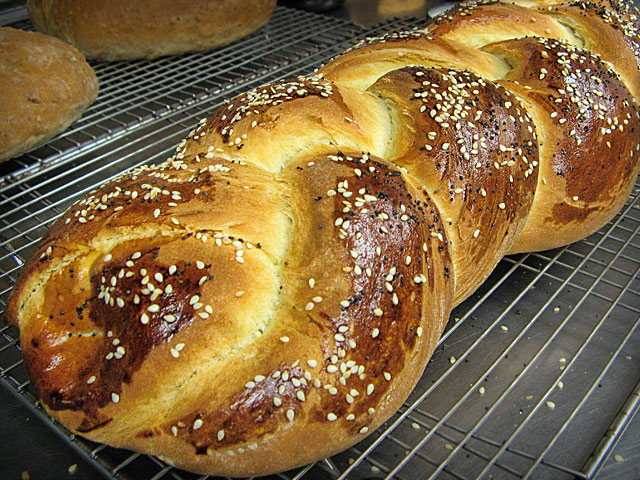

Rona made remarkable Challah bread. Click here to read her blog and get the recipe.

Margherita Pizza
Ingredients
Dough
- 1 1/3 cup warm water
- 1/4 cup milk
- 1 T. dry yeast
- 3 - 3 1/2 cups all-purpose flour
- 1 tsp. salt
- 1 tablespoon honey
- 2 tablespoons olive oil
Tomato Sauce
- 1 - 28 oz. can San Marzano tomatoes seeded and diced
- 2 cloves garlic thinly sliced lengthwise
- ½ cup olive oil
- 1 small bunch basil leaves roughly chopped
- salt
Instructions
Dough
-
In a large bowl, dissolve yeast in warm water. Let stand until bubbly, about 10 minutes.
-
Add milk, flour, salt, honey and olive oil to the yeast. Stir well to combine.
-
Knead dough until smooth. Rub the dough with olive oil and place in a bowl. Cover and let it rise until doubled in volume. This will take about 1 ½ hours.
-
Meanwhile, preheat oven to 350 degrees F.
-
Turn dough out onto a well-floured surface. Form dough into a round and roll out into a circle. Cover with tomato sauce and cheese of your choice. Bake in preheated oven until golden brown, about 20 minutes.
Sauce
-
Heat sauté pan. Add oil, followed by garlic, tomato and basil.
-
Season with salt. Set aside until your pizza dough is ready.
Recipe Notes
Makes 2 pizzas
Note: Fleischmann’s now has Pizza Crust Yeast! Is the first yeast specially designed to just mix, knead, roll and bake. There is no rise after kneading like other yeasts. Has anybody tried this?
Quote of the Day
“If thou tastest a crust of bread, thou tastest all the stars and all the heavens.”
– Robert Browning
If I taste all the stars and heavens when I eat bread, I must be tasting eternity when I eat pizza!
…and then she paused for thought.
Hope you have enjoyed our adventure in the culinary classroom. Join us each week as we continue learning new culinary skills.
You can also read about Rona’s experience on her blog or What’s Cookin online magazine.
Yum
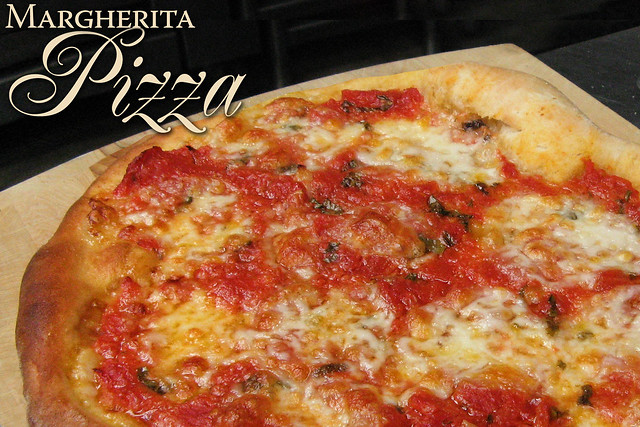
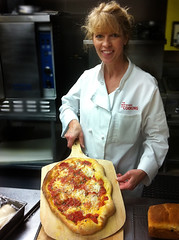
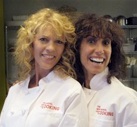
Bookmarking this for 1.) yeastly issues and 2) pizza tonight! I feel smarter already! Although I’ve kneaded a bazillion pounds of bread dough in my day, I never really understood it. Very nice overview to clear up the bread mysteries. Thanks!
Thanks Leslie. Bread is so much fun to make. I am not a big pizza person, but I can be easily swayed with a homemade one.
Looks wonderful Cathy! I have never used honey or milk in pizza dough before, can’t wait to try your recipe! The taste of the dough is really important! My kids like making individual small pizzas and the novelty of letting their friends roll out their own mini ball of dough and top it however they like is very fun. It’s art you can eat! You are inspiring me to make homemade pizza soon! XO! love julie
Thanks Julie, I think you are going to really like this recipe because it is easy and tastes great.
This looks so yummy. I’ve always wanted to try and make bread. Pizza is a fav for sure!
Tina, pizza is a great start to bread making. I was surprised how simple it was.